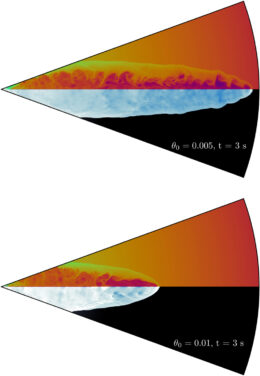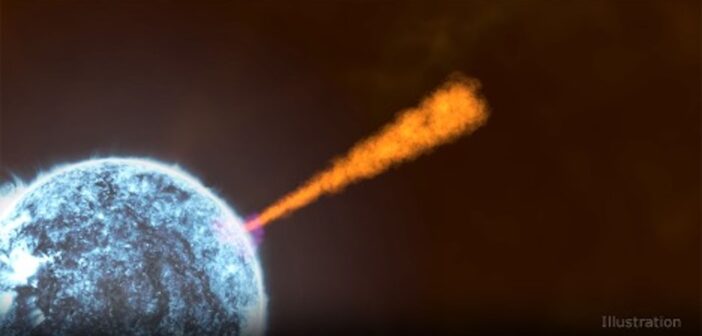Though astronomers already knew that strange things can happen in the final moments of a massive star’s life, a recent model may have just taken the top prize as the most bizarre possible ending. In their last gasps, some stars might be cut clean down the middle by a “relativistic blade.”
Raging, Raving Stars

An artist’s illustration of a jet escaping from a collapsing star. [NASA, ESA and M. Kornmesser]
Though that scenario sounds plenty dramatic, new work by Marcus DuPont and Andrew MacFadyen, New York University, suggests a potentially even more striking scene. Under the right conditions, they surmise that instead of narrow, polar jets, a blast wave could instead expand straight outward along the star’s equator, break through the surface, and cleave the dying star clean in two.

Views of two relativistic blade simulations, one for a narrow blade (top) and one for a wider blade (bottom). In both, the upper hemisphere illustrates density, while the southern illustrates pressure. [DuPont and MacFadyen 2023]
Carving a Star
DuPont and MacFadyen introduce their model of a “relativistic blade” in a playful yet highly technical publication that includes mentions of “pizza slices of uneven length” right alongside topics like “relativistic magnetohydrodynamics” and no fewer than 21 equations in the first five pages. In their telling, as a massive star begins its final collapse, its core can transform into an ultra-dense, ultra-magentized, and rapidly rotating neutron star known as a millisecond magnetar. This rotten heart would seal the star’s doomed fate: the intense winds and magnetic field surrounding the magnetar would deposit enormous quantities of energy into the area around the core that must escape to the surface. Thanks to the magenetar’s spin, that energy would be concentrated into narrow “lamina,” or blades, of outflowing matter that would propagate outwards in just a few seconds.
Moving beyond mathematical musings and into numerical simulations, the pair used software developed earlier by DuPont to illustrate a few caveats of their model. For one, the blades would have to be initially more collimated than their jet counterparts, and for another, the width of the blades has a strong impact on their efficiency and breakout time. But, under a reasonable set of conditions, the simulations show that the blades would “affec[t] a clean slice through the progenitor.”
Consequences of Slashed Stars
Though everyone loves a good star-killing relativistic blade for its own sake, DuPont and MacFadyen did have practical considerations in mind when concocting such a sci-fi sounding model. It’s not currently clear where mysterious flashes of high-energy radiation known as gamma-ray bursts actually come from. Astronomers have developed several models to explain their observations of these bursts, and one of the leading ideas is the earlier-mentioned jets, which would crackle with gamma rays on their journey from their stars’ cores. These blades, too, would unleash gamma rays as they cut through their stars, and thus could also be a source of the observed flashes.
DuPont and MacFadyen suggest that how these bursts fade over time would differ between stars pierced by jets and those cut by blades, meaning that detailed observations may be able to tell the two mechanisms apart some day. They also suggest that more complex models are needed to dial what these blades would look like and how likely they are to arise. That’s great news both for serious astronomers hoping to better understand gamma-ray bursts and space-opera fans alike, who can both look forward to more work on this dramatic hypothesis.
Citation
“Stars Bisected by Relativistic Blades,” Marcus DuPont and Andrew MacFadyen 2023 ApJL 959 L23. doi:10.3847/2041-8213/ad132c

